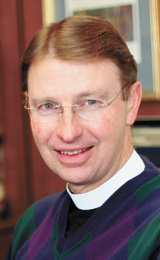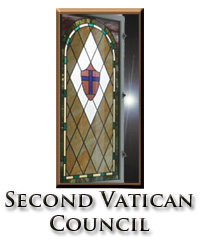(Editor’s note: This is the final of six talks that local religious leaders gave at St. Ambrose University in Davenport on Oct. 10, the vigil of the 50th anniversary of the opening of the Second Vatican Council. The Rev. Richard Priggie is chaplain of Augustana College in Rock Island, Ill.)
By Rev. Richard Priggie

Observers of the Second Vatican Council have noted that the announcement of the council was timed precisely to emphasize its ecumenical purpose. It happened in January 1959, on the Feast of the Conversion of St. Paul, the end of the annual octave for Christian Unity, at the principal church in Rome dedicated to St. Paul.
The heir of St. Peter, John XXIII, went out of his way, in other words, to reach out to the traditional heirs of St. Paul, to include them in what the people called “the quest for unity and for grace” which he hoped the council would be.
One of the nine decrees of the council is the Decree on Ecumenism, which sets a very irenic tone. It proclaims confidently that the unfortunate divisions which occurred between Christians over the course of centuries did not succeed in destroying what it calls “the communion of grace” which still unites us. It speaks of “the many elements of sanctification and of truth which are found outside the visible confines of the Catholic Church.”
 This open and appreciative tone has paved the way for numerous official dialogues since Vatican II between the Catholic Church and Lutherans, Anglicans, the Reformed, Baptists, Methodists, the Disciples of Christ, Pentecostals and Evangelicals. Perhaps the most profound breakthrough, at least from a Lutheran perspective, occurred in 1999 with the Joint Declaration on the Doctrine of Justification, which proclaimed that Lutherans and Catholics “share a common understanding of justification by God’s grace through faith in Christ.” Wow. A lot of blood, sweat and tears were spilled over 500 years because of what we now proclaim to be an agreed-upon understanding.
This open and appreciative tone has paved the way for numerous official dialogues since Vatican II between the Catholic Church and Lutherans, Anglicans, the Reformed, Baptists, Methodists, the Disciples of Christ, Pentecostals and Evangelicals. Perhaps the most profound breakthrough, at least from a Lutheran perspective, occurred in 1999 with the Joint Declaration on the Doctrine of Justification, which proclaimed that Lutherans and Catholics “share a common understanding of justification by God’s grace through faith in Christ.” Wow. A lot of blood, sweat and tears were spilled over 500 years because of what we now proclaim to be an agreed-upon understanding.
It turns out that talking to one another clears up misunderstanding and sometimes resolves differences. It turns out that relationship trumps doctrine, that among family — what the council again called “the communion of grace” — we can expect to learn from one another, not just about one another.
It was clearly the Second Vatican Council, in its spirit of gratitude and hopefulness, that has led to a springtime of ecumenical understanding and communion and has infected especially this generation of young adults with a predisposition to want to discover commonalities rather than being stopped by differences. This is something to rejoice in and build upon today.
When I was a teenager, one of my good friends was another Lutheran named Billy Wagley. Now, Billy grew to stand about 6 feet five inches tall and to weigh 280 pounds, but even in his adulthood he was called Billy by his parents. In high school, it happens that Billy fell deeply, hopelessly in love with a Catholic girl … which was delightful and all consuming to Billy at the same time that it was cause for alarm for his parents. I’ll never forget the day that Billy told me that his mother had pulled him aside and had, with the greatest seriousness, given him this nugget of wisdom: “Now Billy,” she had said, “it’s just as easy to fall in love with a Lutheran as with a Catholic.”
I hope you won’t consider that I have trivialized the ecumenical legacy of Vatican II by saying that these days Lutheran parents almost never give that advice to their children anymore. It’s not that there are no differences between us that remain to be talked over, understood and somehow transcended. It’s just that “the quest for unity and for grace” begun by Vatican II has been so delicious and so encouraging that we can no longer imagine Church without understanding at the same time that never-ending quest. Thanks be to God.







